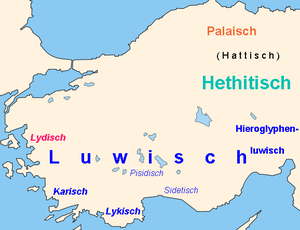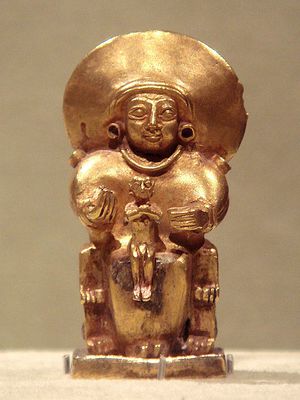アリンナの太陽女神
アリンナの太陽女神(Sun goddess of Arinna)は時にはアリニッティ(Arinniti)あるいはウルセム(Wuru(n)šemu)と同一視される[1]。女神はヒッタイト神話の最高神で、天候神タルフンナの妻とされる。女神はヒッタイト王国の守護者で、「大地の女王」と呼ばれていた。太陽女神信仰の中心は聖なる都市アリンナだった。
アリンナの太陽女神に加えて、ヒッタイトでは「大地の太陽女神」と「天の男性の太陽神」が信仰されていた。ルウィ人の間では、独自に古いインド・ヨーロッパ祖語の太陽神ティワズが信じられた。ヒッタイト初期の北方文化圏には、男性の太陽神は存在しなかったと思われる。[2]
文書に遺されている様々な太陽神達は、単に楔型文字でdUTU (太陽神)としか書かれていないため、区別することが難しい。その結果、太陽神達の解釈が議論の的となっている。
家族と神話
アリンナの太陽女神と天候神タルフンナは一対の夫婦神として、共にヒッタイトの神殿の最高位を占めた。彼らの娘はメズラといい、メズラ女神の娘はジンツヒといった。他にも都市ネリクの天候神、都市ジパランダの天候神、穀物神テリピヌが彼らの子神とされた。鷲が太陽女神の伝令とされた。
太陽女神は、神話にほとんど登場しない。ハッティ神話の断片には、女神の住まいが都市リジナに建てられた、と記されている。別の神話には太陽女神のリンゴの木の事が書かれている。
1本のリンゴの木が井戸のほとりに立っていて、血のように赤い実で覆われていた。アリンナの太陽女神はリンゴを見て、リンゴで彼女の輝く杖を飾った。
___KUB 28.6 Vs. I 10’-13’ = II 10’-13’
起源と発展
アリンナの太陽女神は元はハッティ族に起源があり、ハッティ族はエスタン(Eštan)という名で信仰していた。エスタンのハッティ族の中での通り名の一つがウルセム(「大地の母」という意味か?)だった。[3]
ヒッタイト古王国の時代から、エスタンはヒッタイトの主神だった。「神の都市」であるアリンナは、最初にヒッタイトの王たちが戴冠式を挙げる場所であり、皇帝の3つの聖なる都市のうちの一つだった。女神のハッティ族の名前は、ヒッティ族のイスタヌ(Ištanu)とウルンジム(Urunzimu)という名に訳された。また、ヒッティ族は、太陽女神をアリニッティ(アリンナ神)として祈りを捧げた。「アリンナの」という通り名は、ヒッタイト中王国時代のみ、フルリ人からヒッタイトが受け入れた天の男性の太陽神と、太陽女神とをはっきりと区別するために使用された。[4]
ヒッタイト新王国時代、太陽女神はシリア系フルリ人の女神ヘパト(Ḫepat)と同一視され、ヒッタイト王の妃だったプドゥヘパは彼女の祈祷文の中で太陽女神のことを二つの名前で表した。
Sun goddess of Arinna, my lady, queen of all lands! In the Land of Ḫatti, you ordained your name to be the "Sun goddess of Arinna", but also in the land which you have made the land of the cedar, you ordained your name to be Ḫepat.
___CTH 384[5]
Royal ideology
From the Hittite Old Kingdom, the Sun goddess of Arinna legitimised the authority of the king, in conjunction with the weather god Tarḫunna. The land belonged to the two deities and the established the king, who would refer to the Sun goddess as "Mother".[6] King Ḫattušili I would hold the Sun goddess in his lap.[7] Several queens dedicated cultic solar discs to the Sun goddess in the city of Taḫurpa. During the Hittite New Kingdom, the Sun goddess was said to watch over the king and his kingdom, with the king as her priest and the queen as her priestess. The Hittite king worshiped the Sun goddess with daily prayers at sun set. The Hittite texts preserve many prayers to the Sun goddess of Arinna: the oldest is from Arnuwanda I, while the best known is the prayer of Queen Puduḫepa, cited above.
Cult
The most important temple of the Sun goddess was in the city of Arinna; there was another on the citadel of Ḫattuša. The goddess was depicted as a solar disc. In the city of Tarḫurpa, several such discs were venerated, which had been donated by the Hittite queens. King Ulmi-Teššup of Tarḫuntašša donated a Sun disc of gold, silver and copper to the goddess each year, along with a bull and three sheep. She was also often depicted as a woman and statuettes of a sitting goddess with a halo may also be depictions of her.[8]
The deer was sacred to the Sun goddess and Queen Puduḫepa promised to give her many deer in her prayers. Cultic vessels in the shape of a deer presumably were used for worship of the Sun goddess. It is also believed that the golden deer statuettes from the Early Bronze Age, which were found in the middle of the Kızılırmak River and belong to the Hattian cultural period, ere associated with the cult of the Sun goddess.
Ištanu
The name Ištanu is the Hittite form of the Hattian name Eštan and refers to the Sun goddess of Arinna.[疑問?][9] Earlier scholarship understood Ištanu as the name of the male Sun god of the Heavens,[10] but more recent scholarship has held that the name is only used to refer to the Sun goddess of Arinna.[11] Volkert Haas, however, still distinguishes between a male Ištanu representing the day-star and a female Wurunšemu who is the Sun goddess of Arinna and spends her nights in the underworld.[12]
See also
- List of solar deities
Bibliography
- Maciej Popko: Arinna. Eine heilige Stadt der Hethiter; Studien zu den Boğazköy-Texten Vol. 50, Wiesbaden 2009. ISBN 978-3-447-05867-4.
- Volkert Haas: Geschichte der hethitischen Religion; Handbuch der Orientalistik, Part 1, Vol. 15; Brill 1994. ISBN 90-04-09799-6.
References
- ↑ Arinna.December 27, 2018 - via Wikipedia.
- ↑ Maciej Popko: Zur luwischen Komponente in den Religionen Altanatoliens; AOF 34 (2007), 63–69
- ↑ Jörg Klinger: Untersuchungen zu Rekonstruktion der hattischen Kultschicht. Studien zu den Boǧazköy-Texten, Harrassowitz, Wiesbaden 1996, ISBN 3-447-03667-2
- ↑ Piotr Taracha: Religions of Second Millennium Anatolia. Wiesbaden 2009. ISBN 978-3-447-05885-8. S. 89
- ↑ Dietrich Sürenhagen: Zwei Gebete Ḫattušilis und der Puduḫepa. Textliche und literaturhistorische Untersuchungen; Aof 8 (1981), pp. 83–168.
- ↑ Maciej Popko: Arinna. Eine heilige Stadt der Hethiter; Studien zu den Boğazköy-Texten Bd. 50, Wiesbaden 2009. ISBN 978-3-447-05867-4. p. 28
- ↑ Volkert Haas: Geschichte der hethitischen Religion; Handbuch der Orientalistik, Abt. 1, Bd. 15; Brill 1994. ISBN 90-04-09799-6. S. 585
- ↑ Maciej Popko: Arinna. Eine heilige Stadt der Hethiter; Studien zu den Boğazköy-Texten Bd. 50, Wiesbaden 2009. ISBN 978-3-447-05867-4. pp. 30
- ↑ Maciej Popko: Arinna. Eine heilige Stadt der Hethiter; Studien zu den Boğazköy-Texten Bd. 50, Wiesbaden 2009. ISBN 978-3-447-05867-4. p. 27
- ↑ Einar von Schuler: "Kleinasien: Die Mythologie der Hethiter und Hurriter," in: Wörterbuch der Mythologie. Stuttgart 1965. pp. 198 f.
- ↑ Jörg Klinger: Untersuchungen zu Rekonstruktion der hattischen Kultschicht; Studien zu den Boǧazköy-Texten 37, Wiesbaden 1996, ISBN 3-447-03667-2
- ↑ Volkert Haas(2011), Religionen des Alten Orients: Hethiter. Göttingen. p.226. ISBN 978-3-525-51695-9.



